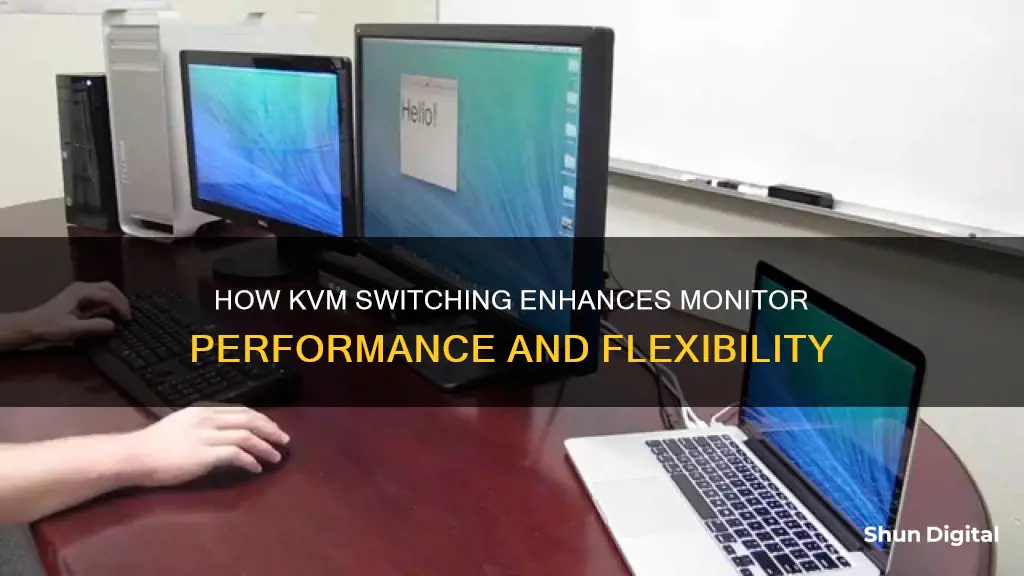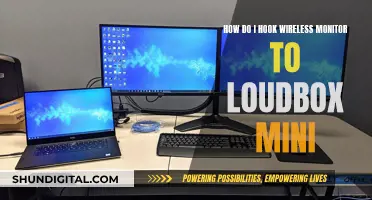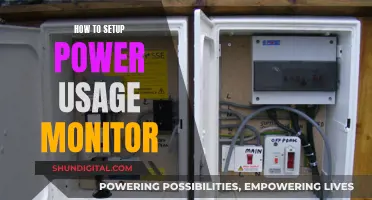
A KVM switch, short for Keyboard, Video, and Mouse switch, is a hardware device that allows users to control multiple computers using a single set of peripherals, usually on a single screen. This can be done by pressing a button or using a hotkey combination on the keyboard. KVM switches are traditionally external devices, but they can also be built into monitors, which saves desk space and eliminates the need for extra keyboards, mice, and monitors. Built-in KVM switches are becoming more common in gaming monitors, as well as creative and work-focused monitors.
| Characteristics | Values |
|---|---|
| Purpose | Control multiple computers with a single set of peripherals |
| Peripherals | Keyboard, video, mouse |
| Connection | Video cable |
| Switching | Button, hotkey combination, remote |
| Ports | USB, HDMI, DVI, VGA |
| Resolution | Maximum resolution depends on the KVM switch |
| Operating systems | Compatible with different operating systems |
| Setup | Easy to set up |
| Cost | Cost-efficient, eliminates the need for extra peripherals |
| Space | Reduces desk clutter |
What You'll Learn
- KVM switches allow users to control multiple computers with a single set of peripherals
- KVM switches save time, increase productivity, and streamline workflow
- KVM switches can be built into monitors
- KVM switches can support multiple monitors
- KVM switches are especially useful for designers, photographers, programmers, and gamers

KVM switches allow users to control multiple computers with a single set of peripherals
KVM switches (short for Keyboard, Video, Mouse switches) are hardware devices that allow users to control multiple computers from a single set of peripherals. Peripherals can include a keyboard, video monitor, mouse, or anything else used to control a PC. KVM switches are designed to enable a single user to operate multiple computers from a single workstation, increasing productivity and extending the workspace.
KVM switches are particularly useful for those who use multiple computers, such as a home PC and a work notebook, and want to view content from both on a single screen without constantly plugging and unplugging cables. With a KVM switch, users can press a button or use a keyboard shortcut to instantly switch between computers and control them from the same set of input devices. This eliminates the need for cable swapping, moving devices, or other inconveniences associated with using multiple computers.
When purchasing a KVM switch, it is important to consider the number of computers, monitors, and peripherals that will be used, as well as the types of ports and cables required. Most mainstream KVM switches support between two to four computers, one to three monitors, and two to four peripherals. It is also important to ensure that the KVM switch supports the native resolution and refresh rate of the display.
In recent years, some monitors have started to include built-in KVM switches, providing the same functionality without the need for a separate device. Virtual KVM software solutions are also available, offering benefits such as ease of setup and customizable configurations. However, hardware KVM switches remain a popular choice due to their simplicity, reliability, and low cost.
Ankle Monitors: What Materials Are Used and Why
You may want to see also

KVM switches save time, increase productivity, and streamline workflow
KVM, which stands for Keyboard, Video, and Mouse, is a hardware device that allows users to control multiple computers using a single set of peripherals. This means that users can work on a PC and a laptop simultaneously, with the ability to toggle between sources with the press of a button or the use of a hotkey combination. This saves users from the hassle of constantly plugging and unplugging cables when switching between devices, which can be time-consuming and disruptive to workflow.
With a KVM switch, users can easily switch between their work, personal, and gaming PCs without having to move devices around or deal with cable swapping. This not only saves time but also reduces the number of peripherals needed, such as keyboards, mice, and monitors, cutting down on hardware costs and desk space.
Additionally, KVM switches offer flexibility in terms of connectivity. They support various ports, including USB, HDMI, DVI, and VGA, and can even support multiple monitors, allowing users to connect multiple displays and switch between computers on different screens.
For example, imagine a user with a work laptop and a home computer with multiple monitors, a keyboard, and a mouse. With a KVM switch, they can easily switch between their work laptop and home computer, using the same peripherals for both. This not only saves time and increases productivity but also streamlines their workflow, providing a seamless transition between tasks on different devices.
Furthermore, KVM switches are evolving to meet the needs of different users. For instance, KVM switches with built-in docking features offer additional ports for LAN, SD card readers, and Toslink Out, providing even more connectivity options for users.
Overall, KVM switches offer a convenient and efficient way to manage multiple computers, making them an essential tool for professionals looking to save time, increase productivity, and streamline their workflow.
Tracking Team Performance: Strategies for Effective Monitoring
You may want to see also

KVM switches can be built into monitors
KVM switches, short for Keyboard, Video, and Mouse switches, are traditionally external hardware devices that allow users to control multiple computers using a single set of peripherals. They are useful for those who want to work on multiple devices, such as a PC and a laptop, at the same time, without the hassle of constantly plugging and unplugging cables.
However, KVM switches can also be built into monitors. This integrated solution offers the same functionality as an external KVM switch but with the added benefit of reduced desk clutter, as it eliminates the need for an additional device. More and more PC monitors are now being released with built-in KVM switches, providing a neat and tidy solution for users.
A monitor with a built-in KVM switch can be considered a multi-input monitor with the functionality of a USB switch incorporated. These monitors typically have USB-A ports for connecting peripherals like keyboards and mice, as well as USB-B ports to connect to computers. Some newer monitors also provide Type-C ports, which can carry both video and USB signals, simplifying the KVM switching process.
While monitors with built-in KVM functions are not yet widely available on the market, they offer a space-saving alternative to external KVM switches. They are particularly useful for those with limited desk space who want to avoid the premium price of a separate KVM switch. However, it is important to note that built-in KVM monitors may have limitations in terms of the number of supported devices and the availability of USB ports.
Overall, KVM switches, whether built into monitors or external devices, provide a convenient and efficient way to manage multiple computers, making them an increasingly popular feature in home and office setups.
Easy Steps to Calibrate Your External Monitor Like a Pro
You may want to see also

KVM switches can support multiple monitors
KVM switches are a great solution for those who want to use multiple computers with the same peripherals and displays. They are especially useful for those who want to avoid the hassle of cable swapping and other awkwardness that comes with using multiple computers.
Some KVM switches can support up to three monitors, while others can support up to eight monitors. It is important to note that the number of supported monitors depends on the specific model of the KVM switch.
When choosing a KVM switch, it is important to consider the number of computers, monitors, and peripherals that will be connected. Additionally, the type of cables and ports required, such as HDMI, VGA, DisplayPort, USB-A, or USB-C, should be taken into account.
- CKL HDMI 2 Port Dual Monitor KVM Switch: This switch offers three USB ports, an audio jack, and a microphone jack. It supports two PCs, two monitors, and multiple peripherals.
- TESmart Dual-Monitor KVM Switch: This switch offers high-end features such as the ability to see both computers simultaneously on different monitors. It also supports keyboard shortcuts for switching.
- JideTech 4 Port KVM Switch: This switch supports up to four HDMI devices and offers five different switching methods.
- OREI KVM Switch: This switch has a sleek design and supports three devices, including PCs, laptops, Android smartphones, and gaming consoles. It offers a USB-C port and 4K resolution.
- Steetek 2 Port Dual Monitor KVM Switch: This switch supports 4K resolution and includes a wireless keyboard and mouse. However, it only offers two switching modes.
KVM switches with built-in support for multiple monitors can streamline your setup and provide a seamless experience when working with multiple computers and displays.
Ankle Monitors: A Necessary Surveillance Tool for Law Enforcement
You may want to see also

KVM switches are especially useful for designers, photographers, programmers, and gamers
KVM switches are a great solution for people who use multiple devices, such as designers, photographers, programmers, and gamers. They can save time, space, money, and effort by eliminating the need for cable swapping and device rearranging. With a simple button press, users can switch between their work, personal, and gaming PCs, using a single set of peripherals. This is especially beneficial for those who use multiple devices with different operating systems, as it provides a seamless transition between them.
For designers, photographers, and other creative professionals who work with high-resolution images and videos, KVM switches ensure that they can work with the required display resolution without any compromise. Most KVM switches support a minimum resolution of 1080p, while also accommodating higher resolutions such as 4K and 1440p. This is crucial for professionals who require accurate colour representation and detailed visuals.
Programmers often juggle multiple projects and coding environments, and a KVM switch allows them to effortlessly switch between different computers or laptops. This enables programmers to work on diverse projects without the hassle of disconnecting and reconnecting peripherals. Additionally, KVM switches support multiple peripherals, including printers, webcams, speakers, and external microphones, which are commonly used by programmers for various tasks.
Gamers can also benefit from KVM switches, especially those who play on multiple platforms or devices. With a KVM switch, gamers can easily transition between their gaming desktop, personal laptop, or console without the tedious process of unplugging and reconnecting cables. This enhances their gaming experience by providing quick access to different devices, ensuring they can get back to their game promptly.
KVM switches offer convenience, efficiency, and flexibility for designers, photographers, programmers, and gamers by simplifying the process of using multiple devices and peripherals. They eliminate the clutter of cables and save time, making it easier for professionals and enthusiasts to focus on their tasks without technical distractions.
Finding Apple Monitor Versions: A Step-by-Step Guide
You may want to see also
Frequently asked questions
KVM stands for Keyboard, Video, and Mouse. It is a hardware device that allows users to control multiple computers using a single set of peripherals, usually on a single screen.
The KVM switch is connected to the monitor through a video cable, enabling it to display the output from the selected computer. Users can switch between different computers by pressing a button or using a hotkey combination on their keyboard.
A monitor with a built-in KVM switch can save space and cost, enhance convenience and efficiency, and reduce the need for additional peripherals, such as extra keyboards, mice, and monitors.







